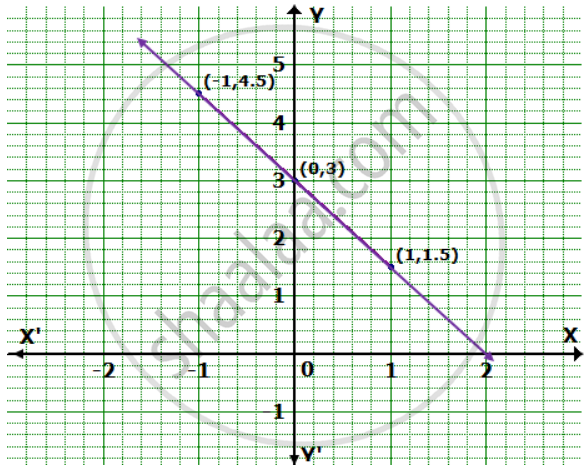Advertisements
Advertisements
प्रश्न
Draw the graph for each of the following equation: Also, find the coordinates of the points where the graph of the equation meets the coordinate axes:
`(1)/(2) x + (1)/(3) y` = 1
उत्तर
Given, `(1)/(2) x + (1)/(3) y` = 1
⇒ 3x + 2y = 6
⇒ 2y = 6 - 3x
⇒ y = `(6 - 3x)/(2)`
Corresponding values of x and y can be tabulated as follows :
| X | 0 | 1 | -1 |
| Y | 3 | 1.5 | 4.5 |
Plotting the points (0, 3), (1, 1.5) and (-1, 4.5),
we get the following graph :
Thus, the graph of the equation meets the X-axis at (2, 0) and Y-axis at (0, 3).
APPEARS IN
संबंधित प्रश्न
Plot the points (3, 5) and (− 1, 3) on a graph paper and verify that the straight line passing
through these points also passes through the point (1, 4).
Draw the graph for the equation, given below :
3x + 2y = 6
Draw the graph (straight line) given by equation x - 3y = 18. If the straight line is drawn passes through the points (m, - 5) and (6, n); find the values of m and n.
Use graph paper for this question. Draw the graph of 2x - y - 1 = 0 and 2x + y = 9 on the same axes. Use 2 cm = 1 unit on both axes and plot only 3 points per line. Write down the coordinates of the point of intersection of the two lines.
By drawing a graph for each of the equations 3x + y + 5 = 0; 3y - x = 5 and 2x + 5y = 1 on the same graph paper; show that the lines given by these equations are concurrent (i.e. they pass through the same point). Take 2 cm = 1 unit on both the axes.
The graph of the linear equation 2x + 3y = 6 is a line which meets the x-axis at the point ______.
The point (0, 3) lies on the graph of the linear equation 3x + 4y = 12.
The following observed values of x and y are thought to satisfy a linear equation. Write the linear equation:
| x | 6 | – 6 |
| y | –2 | 6 |
Draw the graph using the values of x, y as given in the above table. At what points the graph of the linear equation cuts the y-axis
Draw the graph of the linear equation 3x + 4y = 6. At what points, the graph cuts the x-axis and the y-axis.
The force exerted to pull a cart is directly proportional to the acceleration produced in the body. Express the statement as a linear equation of two variables and draw the graph of the same by taking the constant mass equal to 6 kg. Read from the graph, the force required when the acceleration produced is (i) 5 m/sec2, (ii) 6 m/sec2.
